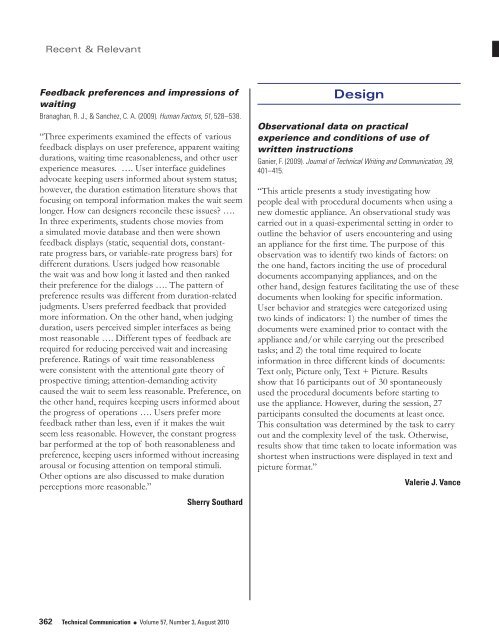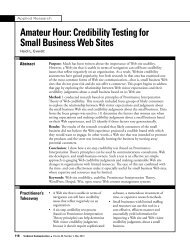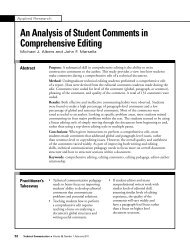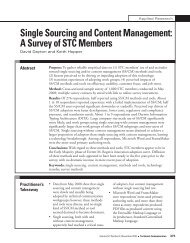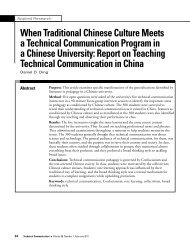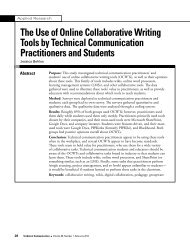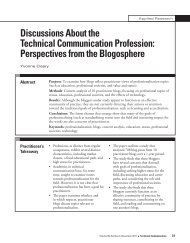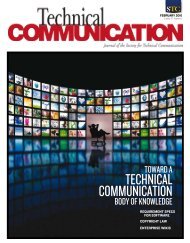Recent & RelevantFeedback preferences and impressions ofwaitingBranaghan, R. J., & Sanchez, C. A. (2009). Human Factors, 51, 528–538.“Three experiments examined the effects of variousfeedback displays on user preference, apparent waitingdurations, waiting time reasonableness, and other userexperience measures. …. User interface guidelinesadvocate keeping users informed about system status;however, the duration estimation literature shows thatfocusing on temporal information makes the wait seemlonger. How can designers reconcile these issues? ….In three experiments, students chose movies froma simulated movie database and then were shownfeedback displays (static, sequential dots, constantrateprogress bars, or variable-rate progress bars) fordifferent durations. Users judged how reasonablethe wait was and how long it lasted and then rankedtheir preference for the dialogs …. The pattern ofpreference results was different from duration-relatedjudgments. Users preferred feedback that providedmore information. On the other hand, when judgingduration, users perceived simpler interfaces as beingmost reasonable …. Different types of feedback arerequired for reducing perceived wait and increasingpreference. Ratings of wait time reasonablenesswere consistent with the attentional gate theory ofprospective timing; attention-demanding activitycaused the wait to seem less reasonable. Preference, onthe other hand, requires keeping users informed aboutthe progress of operations …. Users prefer morefeedback rather than less, even if it makes the waitseem less reasonable. However, the constant progressbar performed at the top of both reasonableness andpreference, keeping users informed without increasingarousal or focusing attention on temporal stimuli.Other options are also discussed to make durationperceptions more reasonable.”DesignObservational data on practicalexperience and conditions of use ofwritten instructionsGanier, F. (2009). Journal of Technical Writing and Communication, 39,401–415.“This article presents a study investigating howpeople deal with procedural documents when using anew domestic appliance. An observational study wascarried out in a quasi-experimental setting in order tooutline the behavior of users encountering and usingan appliance for the first time. The purpose of thisobservation was to identify two kinds of factors: onthe one hand, factors inciting the use of proceduraldocuments accompanying appliances, and on theother hand, design features facilitating the use of thesedocuments when looking for specific information.User behavior and strategies were categorized usingtwo kinds of indicators: 1) the number of times thedocuments were examined prior to contact with theappliance and/or while carrying out the prescribedtasks; and 2) the total time required to locateinformation in three different kinds of documents:Text only, Picture only, Text + Picture. Resultsshow that 16 participants out of 30 spontaneouslyused the procedural documents before starting touse the appliance. However, during the session, 27participants consulted the documents at least once.This consultation was determined by the task to carryout and the complexity level of the task. Otherwise,results show that time taken to locate information wasshortest when instructions were displayed in text andpicture format.”Valerie J. VanceSherry Southard362 Technical Communication l Volume 57, Number 3, August 2010
Recent & RelevantRecent & RelevantEditingEducationCreating editorial authority throughtechnological innovationLanier, C. R. (2009). Journal of Technical Writing and Communication,39, 467–479.“This article considers a case in which editors created forthemselves an amount of power and authority within anorganization through technological innovation. Usingretrospective analysis and e-mail interviews, the authordiscusses his own previous experience as a technicaleditor at a U.S. Government-run research facilitywhen electronic editing was introduced and used. Theintroduction of electronic editing, the author argues, wasan example of technological innovation, which, as otherresearchers have demonstrated, can create authoritywithin an organization.”Valerie J. VanceExamining editor-author ethics: Realworldscenarios from interviews withthree journal editorsAmare, N., & Manning, A. (2009). Journal of Technical Writing andCommunication, 39, 285–303.“Those who submit manuscripts to academic journalsmay benefit from a better understanding of howeditors weigh ethics in their interactions with authors.In an attempt to ascertain and to understand editors’ethics, we interviewed three current academic journaleditors of technical and/or business communicationjournals. We asked them about the ethical dilemmasthey encountered while working with authors, whetherthe editors formally or informally followed a ‘code ofethics,’ and if they felt obligated to maintain any ethicalcodes in particular. In this article, we discuss the ethicaldimensions of editorial practices using specific ethicalscenarios provided by these three editors. We thenanalyze these scenarios using traditional ethical modelsin our field but also in terms of a less-known butpowerful model of ethical analysis originally proposedby philosopher C. S. Peirce. We argue that Peirce’s‘community of inquiry’ ethics model describes thesejournal editors’ ethics when working with authors.”Valerie J. VanceAssessing technical communicationwithin engineering contexts—tutorialDavis, M. T. (2010). IEEE Transactions on Professional Communication,53, 33–45.“A major challenge in engineering education is toprepare professionals for communicating well inwriting and speaking, using appropriate technologies,within professional contexts. Communication inthe global engineering world includes collaborationon cross-functional teams, virtual-project teammanagement, and writing for multiple, complexaudiences. This tutorial discusses how one smallengineering school has integrated technicalcommunication teaching and assessment throughoutthe curriculum with demonstrated success. Theintegrated curriculum, formative and summativeassessments, and real-world contexts offer one modelto address growing communication challenges.”Gowri SarafThe effect of social presence on affectiveand cognitive learning in an internationalengineering course taught via distancelearningMacKey, K. R. M., & Freyberg, D. L. (2010). Journal of EngineeringEducation, 99, 23–34.“Distance learning course formats can altermodes of information exchange and interpersonalinteraction relative to traditional course formats ….To determine the effect of a distance course formaton the knowledge acquisition (cognitive learning)and satisfaction (affective learning) of students, weinvestigated student learning responses and socialpresence during a graduate-level engineering coursetaught via traditional (i.e., professor present in theclassroom) and synchronous distance-learning formats…. Direct quantification of participation, academicperformance assessment based on homework andexam scores, and survey-based assessments of studentperceptions of the course were collected. Based onthese data, cognitive and affective learning responsesto different technological and interaction-based aspectsVolume 57, Number 3, August 2010 l Technical Communication 363
- Page 1 and 2:
AUGUST 2010Volume 57 Number 3SPECIA
- Page 3 and 4:
PresidentMichael A. HughesVice Pres
- Page 5 and 6:
VoLuME 57, NuMBER 3AUGUST 2010ISSN
- Page 7 and 8:
Guest EditorialKirk St.Amant and Ma
- Page 9 and 10:
Applied ResearchTechnical Communica
- Page 11 and 12:
Applied ResearchNicole St. Germaine
- Page 13 and 14:
Applied ResearchNicole St. Germaine
- Page 15 and 16:
Applied ResearchNicole St. Germaine
- Page 17 and 18:
Applied ResearchNicole St. Germaine
- Page 19 and 20:
Applied ResearchNicole St. Germaine
- Page 21 and 22:
Applied ResearchNicole St. Germaine
- Page 23 and 24:
Applied ResearchNicole St. Germaine
- Page 25 and 26:
Applied TheoryTatiana BatovaIntrodu
- Page 27 and 28:
Applied TheoryTatiana BatovaMoreno,
- Page 29 and 30:
Applied TheoryTatiana BatovaThe Uni
- Page 31 and 32:
Applied TheoryTatiana Batovadoctors
- Page 33 and 34:
Applied TheoryTatiana BatovaTo addr
- Page 35 and 36:
Applied TheoryTatiana Batovathe loc
- Page 37 and 38:
Applied TheoryTatiana BatovaJohnson
- Page 39 and 40:
Applied TheoryTatiana BatovaInterna
- Page 41 and 42:
Applied TheoryMcKee and PorterIntro
- Page 43 and 44:
Applied TheoryMcKee and PorterFor e
- Page 45 and 46:
Applied TheoryMcKee and Porterpubli
- Page 47 and 48:
Applied TheoryMcKee and PorterBecau
- Page 49 and 50:
Applied TheoryMcKee and Porterof th
- Page 51 and 52:
Applied TheoryMcKee and Porterwith
- Page 53 and 54:
Applied TheoryMcKee and PorterA Cop
- Page 55 and 56:
Applied TheoryMcKee and PorterConte
- Page 57 and 58:
Applied TheoryMcKee and PorterWalto
- Page 59 and 60:
Applied ResearchLiza PottsIntroduct
- Page 61 and 62:
Applied ResearchLiza Pottsdoes not
- Page 63 and 64:
Applied ResearchLiza PottsUser’s
- Page 65 and 66:
Applied ResearchLiza Pottsactors, t
- Page 67 and 68:
Applied ResearchLiza PottsDRM has a
- Page 69 and 70: Applied ResearchLiza Pottsmake bett
- Page 71 and 72: Applied ResearchLiza PottsOne viewe
- Page 73 and 74: Applied ResearchLiza Pottsinvolved
- Page 75 and 76: Applied ResearchLiza PottsHayhoe, G
- Page 77 and 78: Applied ResearchInternational Fair
- Page 79 and 80: Applied ResearchTyAnna K. Herringto
- Page 81 and 82: Applied ResearchTyAnna K. Herringto
- Page 83 and 84: Applied ResearchTyAnna K. Herringto
- Page 85 and 86: Applied ResearchTyAnna K. Herringto
- Page 87 and 88: Applied ResearchTyAnna K. Herringto
- Page 89 and 90: Book ReviewsWriting Successful Scie
- Page 91 and 92: Book ReviewsThe Process: Business P
- Page 93 and 94: Book ReviewsHCI Beyond the GUI: Des
- Page 95 and 96: Book ReviewsOrigins of the Specious
- Page 97 and 98: Book Reviewsgenre, and process, top
- Page 99 and 100: Book ReviewsPart One goes from the
- Page 101 and 102: Book Reviewsrather than writers, an
- Page 103 and 104: Book ReviewsHow to Write Fast Under
- Page 105 and 106: Book Reviewsmanagement system (CMS)
- Page 107 and 108: Book Reviewsnearly strangled when h
- Page 109 and 110: Book Reviewsinteractive TV model)
- Page 111 and 112: Book ReviewsOtherwise, Beech shows
- Page 113 and 114: Book Reviewssuch as blog, I found m
- Page 115 and 116: Book Reviewsemployees and effective
- Page 117 and 118: Recent & RelevantSherry Southard, E
- Page 119: Recent & RelevantRecent & RelevantC
- Page 123 and 124: Recent & Relevantworking in a langu
- Page 125 and 126: Recent & RelevantWhat’s the big d
- Page 127 and 128: Recent & RelevantScientific Writing
- Page 129 and 130: Recent & Relevantapplicability. Man
- Page 131: Did You Missthe Summit?Don’t miss


